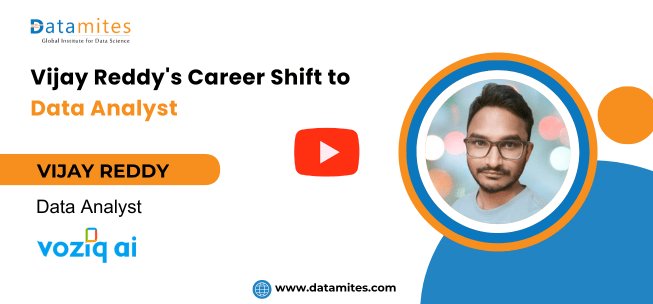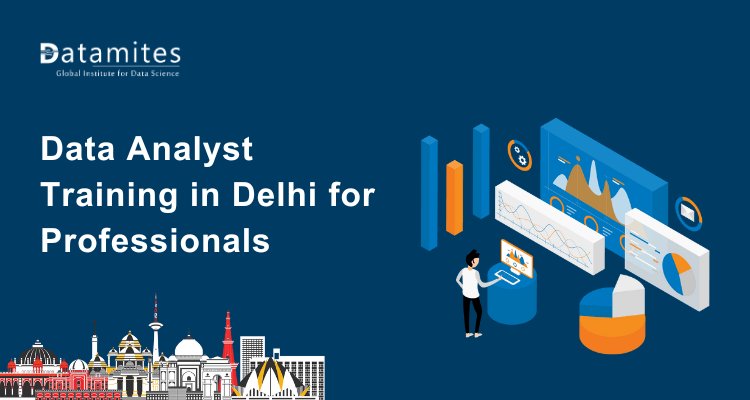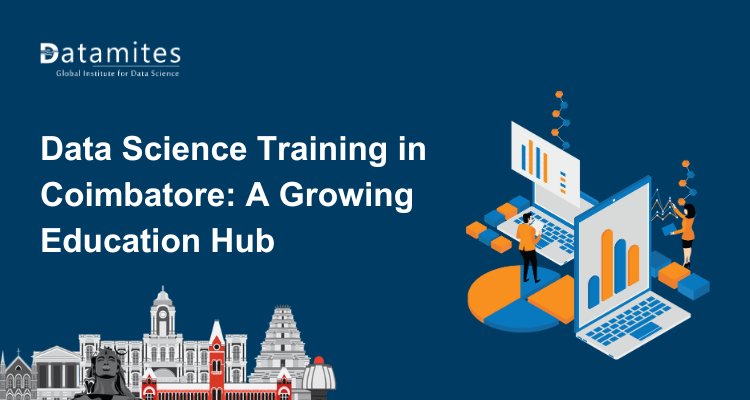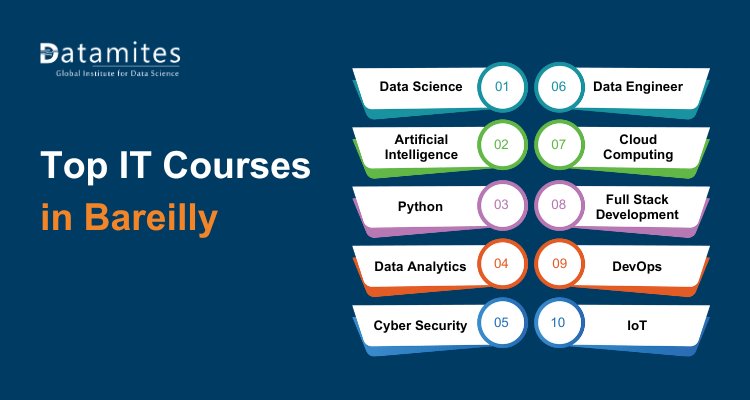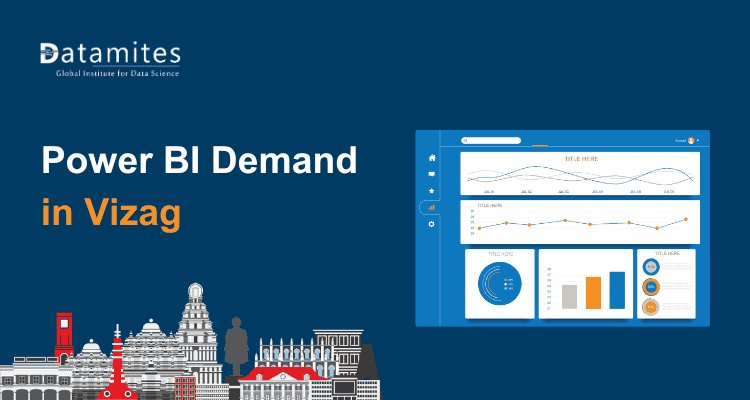Vijay Reddy's Career Shift to Data Analyst
Discover Vijay Reddy’s inspiring journey from civil engineering to a Data Analyst role at Voziq AI. Learn how he upskilled through DataMites, tackled interview challenges, and built a successful tech career. Explore key insights, tools, and tips for transitioning into data analytics.

In today's data-driven world, transitioning into analytics from a non-technical background is no longer just a dream. Vijay Reddy Alugumetla's remarkable journey from a civil engineering graduate to a successful Junior Data Analyst at Voziq AI proves that with the right mindset, learning resources, and perseverance, anyone can make a career shift. In this article, we explore Vijay's experience, challenges, and the strategies he used to succeed in the analytics domain.
From Civil Engineering to Data Analytics: Vijay’s Journey
From civil engineering to a role in data analytics, Vijay Reddy Alugumetla's journey is an inspiring tale of perseverance and smart career transition. In this article, he shares how he overcame challenges, upskilled with one of the best IT Courses at DataMites, and successfully landed a job as a Junior Data Analyst at Voziq AI.
Q1: Can you walk us through your transition from civil engineering to data analytics?
Vijay: I graduated in 2019 with a degree in Civil Engineering and searched for related jobs, but the roles offered low salaries and limited growth. Post-COVID, I explored in-demand careers and discovered data science. I found DataMites through online research and decided to enroll without hesitation.
Q2: How was your experience with the DataMites curriculum?
Vijay: The curriculum was well-structured and aligned with market demands. The mentors, especially Saga, made even complex topics easy to understand. Daily tasks were challenging but crucial for building strong foundational knowledge.
Q3: Was programming difficult coming from a non-technical background?
Vijay: Initially, yes. I had minimal exposure to C programming in college. However, Python was much easier to grasp, even for someone from a civil engineering background. With time and practice, it became manageable.
Q4: What study strategy did you follow during your course and job search?
Vijay: Initially, I focused solely on Python but soon realized SQL and Excel were equally important. I took LinkedIn Learning courses to master them and added certifications to my profile. Building a comprehensive skill set was key.
Q5: What interview challenges did you face, and how did you overcome them?
Vijay: I failed my first interview at Myntra due to weak SQL skills. They asked about JOINs and window functions, which I hadn't mastered. I learned from the experience, improved my SQL, and succeeded in the next interviews.
Refer to the articles below:
- From IT Graduate to Business Data Analyst: Surabhi’s Journey
- Naveen Kumar's Inspiring Career Transition to Data Analyst
- Sethupathi’s transition to Senior Data Analyst
Q6: What are your current responsibilities as a Junior Data Analyst?
Vijay: Initially, I created dashboards and reports using SQL, Excel, and internal BI tools like BIRT. Now, I work on client communication and product development, focusing more on research and feature improvement.
Q7: What tools and platforms do you use daily?
Vijay: Primarily SQL and Excel. For dashboards, we use Elasticsearch and Kibana. Excel is used extensively for client reports and communication.
Q8: What key skills do you recommend aspiring data analysts focus on?
Vijay: Master SQL and Excel. Communication is equally important for presenting insights. BI tools like Power BI or Tableau are helpful, but foundational tools are a must.
Q9: How did you apply for jobs, and what helped you stand out?
Vijay: I used Naukri and LinkedIn daily. I kept my profile updated, shared data-related posts, and built a strong online presence. My current job offer came through LinkedIn.
Q10: Did projects and internships help in job readiness?
Vijay: Absolutely. Real-world projects and internships gave me confidence. Interviewers asked about them, and my hands-on experience set me apart.
Q11: How important is statistics in your job?
Vijay: Very important. Basic concepts like mean, median, and standard deviation are used to verify data quality and consistency.
Q12: How long did it take you to get a job post-course completion?
Vijay: It took about 1.5 years. The effort and consistency matter more than time. Keep learning, practicing, and showcasing your work.
Key Insights from Vijay's Journey to Becoming a Data Analyst
Vijay’s inspiring journey into the world of data analyst career proves that with determination, the right tools, and a strategic approach, anyone can successfully transition into a rewarding tech career—regardless of their background.
- Commit to Continuous Learning and Career Shifts: Vijay’s journey highlights that transitioning into a data analyst role is achievable—even from a non-IT background—through persistent effort, structured learning, and a growth mindset.
- Master Core Technical Tools: Python, SQL, and Excel: Foundational tools like Excel and SQL are essential for data manipulation and analysis. Python, known for its simplicity, is ideal for beginners and widely used in data analytics projects.
- Apply Learning Through Real-World Projects: Hands-on experience is crucial. Working on practical projects not only reinforces your learning but also helps in building a strong portfolio to showcase during job applications.
- Strengthen Communication and Presentation Skills: Effective communication is key in data roles. Being able to present insights clearly and collaborate with teams adds immense value and sets candidates apart in interviews.
- Build an Online Presence and Professional Network: Sharing projects and achievements on LinkedIn enhances visibility and opens doors to opportunities. Vijay’s active presence helped him connect with industry professionals and recruiters.
- Learn from Setbacks and Stay Focused on Growth: Every interview experience, even rejections, is a learning opportunity. Vijay emphasizes the importance of refining your approach, staying patient, and focusing on long-term career development rather than just securing a job.
Vijay’s journey serves as a powerful example of how determination, continuous learning, and the right educational guidance can enable anyone—regardless of their background—to successfully transition into the field of data analytics. Backing this trend, a report by Maximize Market Research projects that the global data analytics market will reach USD 245.53 billion by 2029, reflecting the vast career opportunities available in this rapidly growing and evolving domain.
Refer to the articles below:
- Data Analyst Career Scope in Bangalore
- How to Become a Data Analyst in Bangalore
- Why DataMites Institute for Data Analytics Course in Bangalore
Enrolling in an offline Data Analyst course in Bangalore or other major tech hubs like Bangalore, Chennai, Coimbatore, Hyderabad, Ahmedabad, Delhi, Jaipur, and Mumbai offers practical industry exposure, valuable networking opportunities, and promising career prospects in both data analysis and software development. Datamites Success Stories continue to highlight how learners from diverse backgrounds have transformed their careers through structured training, hands-on projects, and expert mentorship.
DataMites Institute stands out as a premier training provider in domains such as Data Science, Artificial Intelligence, Machine Learning, Python Programming, Data Analytics, Data Engineering, and IoT. With a focus on practical, industry-aligned learning, DataMites empowers students with the core skills required to excel in the fast-paced tech world.
What truly sets DataMites apart is its commitment to excellence and global credibility. The institute offers internationally recognized certifications through esteemed bodies like IABAC and NASSCOM FutureSkills, which significantly enhance learners’ professional value and employability.
Alongside its Data Analyst training in Pune, DataMites also delivers flexible classroom training in top cities including Hyderabad, Bangalore, Coimbatore, Ahmedabad, Jaipur, Delhi, and Mumbai—making high-quality education accessible to aspiring data professionals across India.
